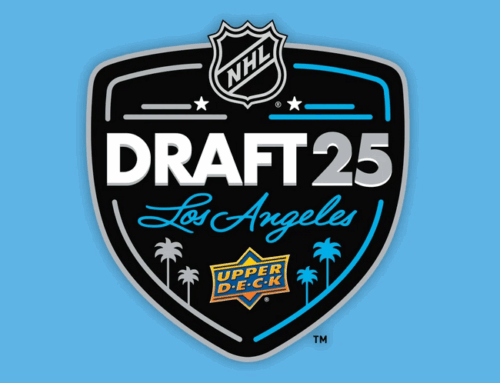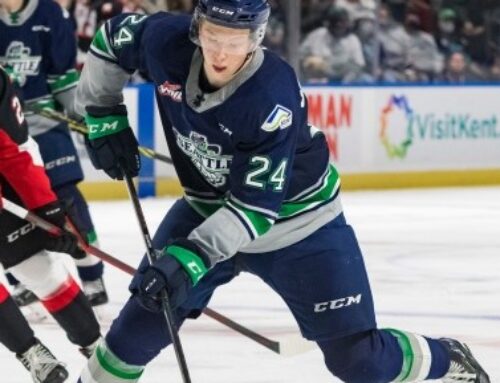Prospect Ramblings: Prospect Ranking Tiers
Pat Quinn
2021-10-21
Welcome to the Thursday prospect ramblings again. I will be pretty sporadic with ramblings for the next couple of months, but I am here to bring you a fun topic for this week.
I want to go over how I look in to tiering prospects at forward, defense, and the always difficult to predict goalies, for our future crystal ball style NHL predictions. I will also add my definition for each category. I feel as though I have a much broader terminology and outlook than others as that is how I like to project
Forward:
Elite – Pretty self-explanatory as this would be a top forward in the NHL with a range of points over a point per game
Top Line – This is a forward that racks up the points on the top line. Essentially a player that plays a ton of minutes and racks up the points for fantasy GMs. The range for points would be just below a point per game with the possibility of a few seasons at or over a point per game, possibly around 0.8-1.10
Top Six – This player can play in the top six, and on the top powerplay, but can also be stuck on the second powerplay and on the second line never really getting a shot to move up. As well as always being steady in points but never a blow away season unless everything goes right. My point range would be about 0.7-0.9
Middle Six – This is where I project most forwards as a lot of very good junior, overseas, or college players usually fall in to this range at the end of the day in the NHL. They can be complimentary top line players, but mostly play on lines two or three and powerplay is never a given. They are usually in the 0.5-0.7 ppg range
Top Nine – This is my real “early safe zone” when projecting forwards as they are likely to make the NHL, but their exact role is not known. They could end up as a top line player or settle on line three. It is an early projecting before they play in higher levels and you can see their usage, as well as NHL talent/contracts in front of them
Bottom Nine – A forward that will be an NHLer but you know will not have a lot of offense at the next level. They are like the previous range but you realize the players ceiling is much lower, and that they can become solid checking line players, or get lucky and play on the second line
Bottom Six – Where a player is gritty or really good defensively and I know they will become an NHL player, but also know they will not score much. The range for this forward is typically 0.4-0.55
Bottom Line – Either a checking only type player, or a forward that is constantly a tweener between the NHL and AHL. Typically, useless for fantasy except for the deepest of leagues
Defense:
Number One – A number One defenseman in every sense, there are not many in the NHL and they can put up close to, or over, a point per game
Top Pairing – A defenseman that is on the top pairing and either quarterbacking PP1 or PP2, usually remain in the high 50’s in points, or around 0.6 ppg
Top Four – These are very good defensemen that sometimes quarterback a powerplay and other times do not but should. They have value in most fantasy leagues and are selected after the top guys are gone. These are also players that I know have the tools to succeed in the NHL and be a good defenseman for an NHL team
#2-#5 – This is my wide range variety where I know a player will make the NHL and could either play on the top pair (while not being the top player), could be a solid middle-pairing defenseman, or might be a top bottom pairing player, but they will never be THE #1 player and there may be a chance that they only play on the bottom pairing
Bottom Four – A solid prospect that likely could be a bottom pairing defenseman that lasts in the NHL for a long time who also had the chance to be a second pairing player if everything goes right
Bottom Pair – A defenseman that is gritty, tough, is big but hits, or is a specialist in the defensive zone only (as an off the glass and out player that is become more and more outdated with the speed and skill required for the NHL). These are the types that NHL GMs always sign
Special Ranking:
Powerplay Specialist – Either a defenseman or forward. They typically play on the bottom pairings but get top powerplay time. They also are not too long for the NHL as they are not good at even strength play
Goalies:
Star – The best of the best really. Just top goalies that stay top goalies for a while and are usually the first off of draft boards on good teams, and still selected even if the team they play on is bad
Above Average – They are good/great and have their off years. They are typically the starters on good/average teams and are relied on by the team and fantasy GMs
Average/1A – A good goalie that never is trusted to play a lot of games, usually injuries or other inconsistency reasons come in to play
1B – The top back ups and goalies that can be relied upon to start for a handful of games while the starter is injured. They also get hot and gobble starts from the 1A/Starter when they struggle
Back-Up – When I am sure they will make the NHL but they will likely never be the starter
***************************
Thanks for reading and if you want to share your own ranking tier list with me, do so on twitter: @FHPQuinn
Pat Quinn





